
Leontopodium nivale, commonly called edelweiss, is a mountain flower belonging to the daisy or sunflower family Asteraceae. The plant prefers rocky limestone places at about 1,800–3,400 metres (5,900–11,200 ft) altitude. It is non-toxic and has been used in traditional medicine as a remedy against abdominal and respiratory diseases. Its leaves and flowers are covered with dense hairs, which appear to protect the plant from cold, aridity, and ultraviolet radiation. It is a scarce, short-lived flower found in remote mountain areas and has been used as a symbol for alpinism, for rugged beauty and purity associated with the Alps and Carpathians. It is a national symbol of several countries, specifically Bulgaria, Austria, Slovenia, Switzerland, and Italy. In Romania it was declared a "monument of nature" in 1931. The Edelweiss day is celebrated on 5 March. According to folk tradition, giving this flower to a loved one is a promise of dedication.

An alpine garden is a domestic or botanical garden, or more often a part of a larger garden, specializing in the collection and cultivation of alpine plants growing naturally at high altitudes around the world, such as in the Caucasus, Pyrenees, Rocky Mountains, Alps, Himalayas and Andes. It is one of the most common types of rock garden.

Androsace, commonly known as rock jasmine, is a genus of flowering plants in the family Primulaceae, second only to Primula in the number of species. It is predominantly Arctic–alpine, with many species in the Himalayas, the mountains of central Asia, the Caucasus, and the southern and central European mountain systems, particularly the Alps and the Pyrenees.

Alchemilla alpina, commonly known as alpine lady's-mantle, is an arctic-montane herbaceous perennial plant native to Europe and Southern Greenland.

Pulsatilla alpina, the alpine pasqueflower or alpine anemone, is a species of flowering plant in the family Ranunculaceae, native to the mountain ranges of central and southern Europe, from central Spain to Croatia. It is an herbaceous perennial growing to 15–30 cm (6–12 in) tall by 20 cm (8 in) wide, and can be found at altitudes of 1,200–2,700 m (3,900–8,900 ft).

An Arctic–alpine taxon is one whose natural distribution includes the Arctic and more southerly mountain ranges, particularly the Alps. The presence of identical or similar taxa in both the tundra of the far north, and high mountain ranges much further south is testament to the similar environmental conditions found in the two locations. Arctic–alpine plants, for instance, must be adapted to the low temperatures, extremes of temperature, strong winds and short growing season; they are therefore typically low-growing and often form mats or cushions to reduce water loss through evapotranspiration.
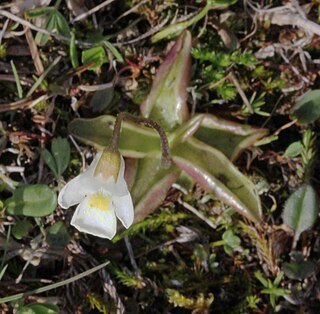
Pinguicula alpina, also known as the alpine butterwort, is a species of carnivorous plant native to high latitudes and altitudes throughout Eurasia. It is one of the most widespread Pinguicula species, being found in mountainous regions from Iceland to the Himalayas. Native to cold climates, it is a temperate species, forming prostrate rosettes of green to red leaves and white flowers in the summer and a tight hibernaculum during a period of winter dormancy in the winter. Like all members of the genus, P. alpina uses mucilaginous glands covering the surface of its summer leaves to attract, trap, and digest arthropod prey.

Cicerbita alpina, commonly known as the alpine sow-thistle or alpine blue-sow-thistle is a perennial herbaceous species of plant sometimes placed in the genus Cicerbita of the family Asteraceae, and sometimes placed in the genus Lactuca as Lactuca alpina. It is native to upland and mountainous parts of Europe.

Papaver alpinum, synonym Oreomecon alpina, the Alpine poppy or dwarf poppy, is a poppy found in the Alps. The circumscription of the species varies considerably. In some treatments, the species is one of a group of related species, and includes several subspecies, four of which are found in Austria. In other treatments, it includes species that have been treated as separate, and has at most one subspecies.

The Viote Alpine Botanical Garden is an alpine botanical garden operated by the Museo tridentino di scienze naturali, and located in Viotte di Monte Bondone, southwest of Trento, Trentino-Alto Adige/Südtirol, Italy. It is open daily in the warmer months; an admission fee is charged.

The Alps are one of the great mountain range systems of Europe stretching approximately 1,200 kilometres (750 mi) across eight Alpine countries from Austria and Slovenia in the east, Switzerland, Liechtenstein, Germany, France to the west and Italy and Monaco to the south. The flora of the Alps are diverse. In the mountains, the vegetation gradually changes with altitude, sun exposure, and location on the mountain. There are five successive life zones, each with distinct landscapes and vegetation characteristics: premontane, montane, subalpine, alpine, and alvar.

Central Europe contains several life zones, depending on location and elevation.
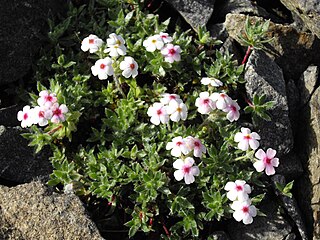
Androsace villosa is an alpine plant, widespread in the mountains of Europe and Asia. It is frequently grown by alpine gardeners.
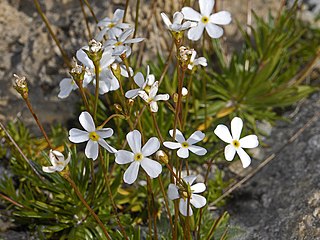
Androsace lactea, the milkwhite rock jasmine, is an alpine plant, in the family Primulaceae.

Androsace sarmentosa, the rock jasmine, is a perennial plant in the family Primulaceae, native to the Himalayas and Tibet. As its synonym Androsace studiosorum it has gained the Royal Horticultural Society's Award of Garden Merit.

Arabis caucasica is a species of flowering plant in the mustard family (Brassicaceae) known by the common names garden arabis, mountain rock cress or Caucasian rockcress.
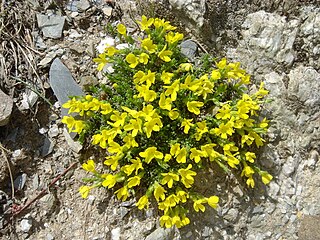
Androsace vitaliana is a species of plant in the primrose family, Primulaceae. It was previously known by the synonym Vitaliana primuliflora. Native to the high mountains of Europe, it is cultivated as an alpine garden plant, being considered easy to grow in well drained soil in a sunny position.
Androsace americana, synonym Douglasia arctica, known as the Mackenzie River dwarf primrose, is a species of flowering plant in the primrose family, Primulaceae. It is native to subarctic North America.

Androsace lanuginosa, called the woolly rock jasmine, is a species of flowering plant in the genus Androsace, native to the western Himalaya. It has gained the Royal Horticultural Society's Award of Garden Merit.
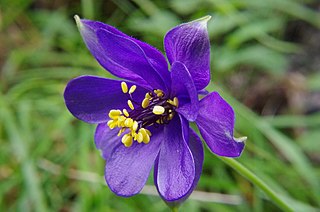
Aquilegia alpina, the alpine columbine or breath of God, is a species of flowering plant in the family Ranunculaceae, native to the Alps, where it is typically found growing on carbonate bedrock.



















